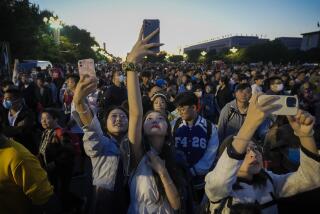China’s population expanded slowly over last decade
- Share via
Reporting from Beijing — As China continues to enforce childbearing limits, its population grew by less than 1% a year in the last decade, but remained the world’s largest at 1.34 billion people, according to census figures released Thursday.
The data released by the Beijing-based National Bureau of Statistics showed that China’s population grew by 5.84% from 2000 to 2010, or 0.57% per year. The slow growth rate was aided by China’s family planning policy, which limits urban couples to one child.
At the same time, the nation’s urban population increased by 13.6 percentage points, meaning city dwellers now make up 49.7% of the total population. Some suspect the large migration to urban centers magnified the effects of the so-called one-child policy.
Besides being increasingly urban, the population is increasingly older, according to the statistics. People age 60 and older now represent 13.26% of the population, an increase of 2.93 percentage points from 2000.
This week, President Hu Jintao reaffirmed his support for the family planning policy, introduced in 1980, which allows many rural couples to have a second child. But the new numbers have alarmed some Chinese population experts more accustomed to burgeoning growth.
“The census results should be wake-up call to Chinese policymakers to stop pushing the gas pedal on an existing downward trend,” said Wang Feng, a population expert and director of the Brookings-Tsinghua Center. At the current rate “each generation will be reduced by a quarter, and eventually we’ll be erased form the face of the Earth.”
One side effect of the family planning rules is the high incidence of abortion of female fetuses in a society that traditionally favors male offspring.
This has led to a gender imbalance in China, with about 48.7% of the population female. By contrast, in the United States 50.3% was female in 2010.
China’s inferred fertility rate is on par with or lower than those of developed countries such as the United States, France and Spain. But even with China’s rapid economic growth, per capita income is still far below those of wealthy countries that also are faced with quickly aging populations.
Because China’s fertility rate is likely to be very low, there will be a larger burden on young families to take care of their elderly parents and grandparents, said experts who made projections despite the lack of official fertility figures.
Even if the rule is altered to allow families to have two children, a policy some news reports have suggested is in the works, population experts doubt it will significantly boost China’s population.
“Young couples in China are just like others around the world,” said Wang, of the Brookings-Tsinghua Center. “Faced with economic uncertainty, more young people in urban areas are content with just one child or no children at all.”
One factor that contributed to the rise of the urban population is the increase in the number of migrant workers seeking employment. About one-sixth of Chinese now live away from the place where they are registered, with many residents of poor rural areas moving to far more economically vibrant cities.
Haas is a news assistant in The Times’ Beijing bureau.
More to Read
Sign up for Essential California
The most important California stories and recommendations in your inbox every morning.
You may occasionally receive promotional content from the Los Angeles Times.










